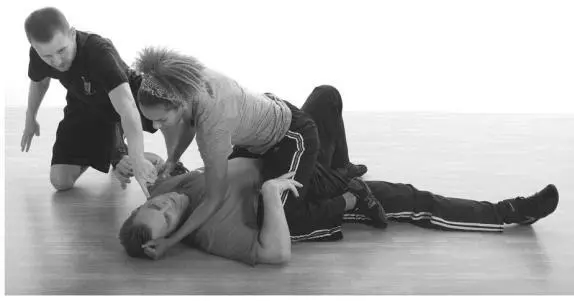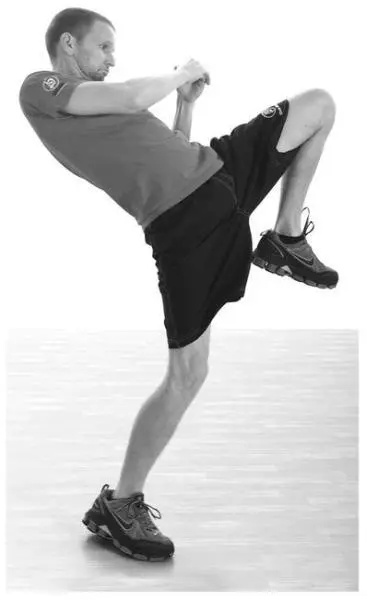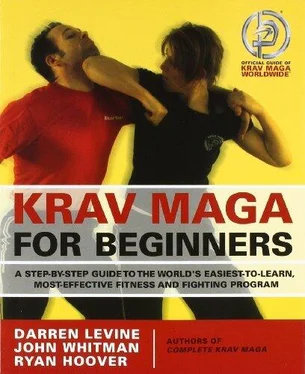Where You Can Train in Krav Maga
Krav Maga Worldwide, at the printing of this book, recognizes over 240 officially licensed training facilities worldwide. These training centers are required to have certified instructors teaching the Krav Maga classes, and the centers and instructors are held to very high training and teaching standards. The certification process is very demanding, with 30 to 40 percent of instructor candidates failing the initial phase of training.
For an updated listing of these centers, please visit the locations page of the Krav Maga Worldwide website at www.kravmaga.com.

Author Ryan Hoover points out a vulnerable point on the attacker.
Krav Maga Philosophy and Principles
Krav Maga is ultimately about problem solving, and while its original purpose was to address violent encounters, the same philosophy can be applied to other facets of daily life. Krav Maga is a no-nonsense, no-frills system that is designed to instill a fighting spirit and aggressive mindset in its students. While Krav Maga recognizes that self-defense is not punishment, and that the ultimate goal is to go home safely, the tenets dictate that the best way to achieve that goal is to react aggressively and decisively.
Don’t get hurt. While this may seem obvious, the intent is far-reaching. This tenet dictates that great lengths should be taken to avoid conflict if at all possible. Often, an improved understanding of the dynamics of violence and violent people will heighten awareness and avoidance. However, if this is not possible, it is imperative that the defender is aggressive in order to eliminate the threat and neutralize the attacker, diminishing the chances for injury.
Train from a position of disadvantage.Life, by its very nature, makes even the most vigilant trainee prone to distraction. Whether it is a mental lapse, complacency, or worse, apathy, lapses are natural. Krav Maga training takes such realities into consideration and forces students to train from a poor state of readiness. Understanding that it is highly probable that a defender will be forced to take action when unprepared, training is typically conducted from a neutral position. This position forces the student to perform techniques without regard to proper footwork, hand positioning, balance, weight distribution, etc. In order for Krav Maga to be the most effective for reality, the techniques and tactics must not rely on being early in the defense or prepared. This is a significant element of Krav Maga training.
Identify and eliminate the immediate danger.Without addressing the true problem, no “technique” or “resolution” can be successful. Often, valuable time is lost while peripheral issues are addressed. Krav Maga stresses that the most imminent danger must be taken care of first, and that it should be done in the most efficient fashion.

Utilize the body’s natural instincts.While other styles or systems may teach techniques that some may deem “better” under given circumstances, most often these techniques work against the body’s natural reactions and require extensive time in training. Techniques such as these are entirely less likely to work under the stress of a violent encounter.
Krav Maga recognizes that fine motor skills are much less effective under the influence of the adrenaline that accompanies stressful situations, so techniques are gross motor by design and draw heavily from what the body would most likely do naturally. This approach increases the likelihood of performing a technique successfully during the stress of a real-life violent encounter. It also lessens the amount of training time needed to achieve a reasonable level of proficiency.
For the average person, and that is the focus, copious training is not practical. Krav Maga training takes into account that the body’s response to violence or fear falls into three categories, typically described as fight, flight, or freeze. This training incorporates drills that encourage decisive reaction under stress, taking the defender from a state of inaction to a state of action quickly.
Deal effectively with secondary dangers that may exist in the attack.Understanding that identifying and eliminating the immediate threat in any attack is paramount to a successful defense, it is also necessary to consider secondary dangers that may result as an extension of the attack or as a by-product of the defense. Secondary dangers are most effectively mitigated through the use of sound tactics and application of the other key principles, such as being explosive and defending and countering simultaneously.
Counterattack as soon as possible, preferably simultaneously to the defense.A strong counterattack is vital to any realistic defense. A strong and aggressive counter is designed to disrupt the ongoing attack. It forces the attacker to react to the defender, as opposed to continuing or adjusting the attack. The sooner this attack is delivered, the quicker the defender is able to shift the “predator vs. prey” paradigm. Remember, virtually all criminals are looking for a victim, not a fight, so an aggressive and immediate counter will also serve to surprise the attacker, creating openings for further counters and escape. Defense does not “win” an altercation!
Attack vulnerable areas.Again, a viable self-defense system must not be based on the defender’s physical attributes. Therefore, Krav Maga emphasizes attacking to vulnerable areas, such as the eyes, jaw, throat, liver, kidneys, groin, fingers, knees, shins, and insteps. Strikes to these areas allow defenders to do maximum damage with minimal effort and strength.
Analyze and use the environment whenever possible.Violent attacks rarely occur in a controlled environment. Krav Maga emphasizes the need to evaluate the environment in order to choose the proper action. As an example, if defending on uneven, unstable, or slippery terrain, upper body strikes are often preferred over kicks.
Training also encourages the use of common objects found on the scene, either offensively (e.g., blunt object for striking) or defensively (e.g., chair as a shield), in order to increase the chances of surviving an attack. This is extremely important since fights are rarely “fair.” If someone is intent on doing harm, the defender must do whatever is necessary, using whatever is available (lamp, bottle, plate, briefcase, fire extinguisher, electrical cord, etc.). This principle applies regardless of what the advantages or disadvantages appear to be in the moment. Fights are dynamic, and variables can change in an instant (introduction of weapons, third parties, injuries, etc.). Krav Maga stresses that defenders do whatever it takes to go home safely.
Mindset: Don’t quit.A proper Krav Maga training regimen will go to great lengths, through specially designed drills, to develop a fighting spirit in each practitioner. In real situations, early recognition of potential violence and consequent variable mitigation are imperative. In times of potential danger, many factors can affect the outcome of the altercation, and most are controlled, at least initially, by the attacker. That said, the fighting spirit developed through Krav Maga training may very well be the one factor under the defender’s control. Therefore, it must be nurtured and cultivated to become pervasive.
Читать дальше














